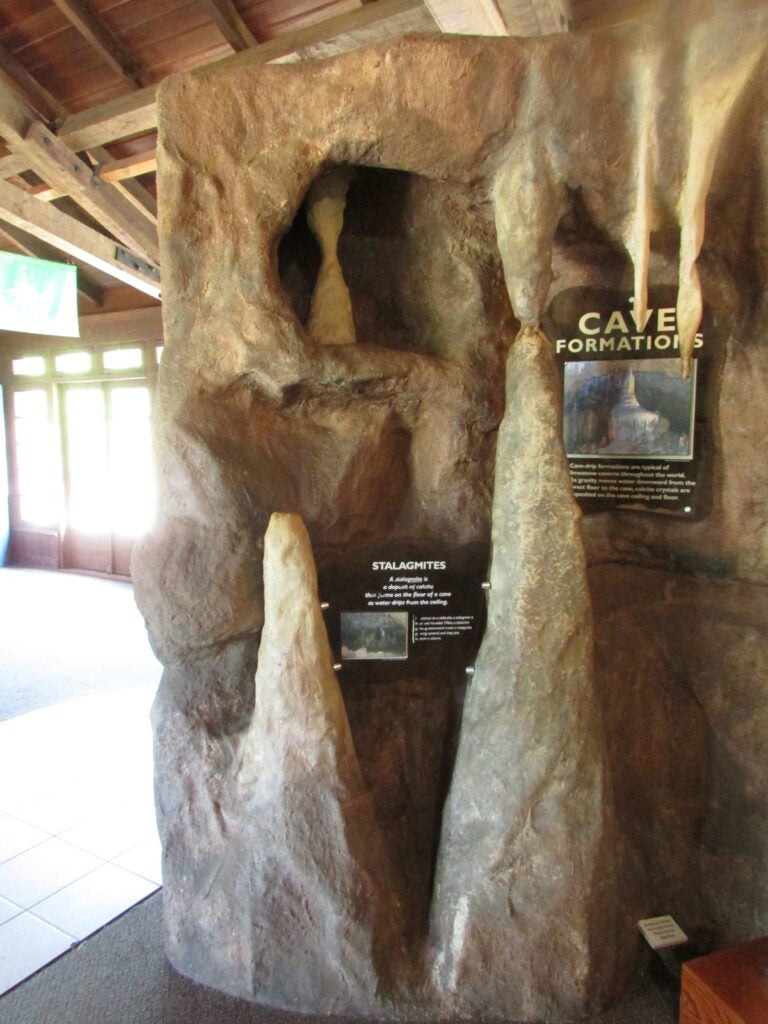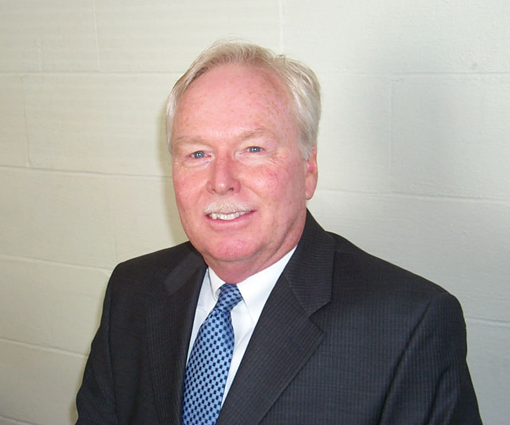Ops! I Fell into Florida – the Underground
Published 7:00 pm Sunday, April 7, 2024

- Since it was so dark below in the cave, I took pictures in the museum where there are reproductions of what is below. This is a duplicate of a formation of stalagmites that exists in the cave.
|
Getting your Trinity Audio player ready...
|
So much to see in our area! I have a list of “must do’s” that is longer than a gator tail! However, in my quest to see everything at once, I have gone off the path that I was on and ended up elsewhere. Sometimes, it is not such a good thing but this was one of those times when, yes, it was good.
Therefore, today I am going to share with you my trip to Florida Caverns State Park and tour a cave. Since it is always 65 degrees below the ground, I am bringing along a thermos of hot coffee. I will share.
Florida Caverns State Park is a 1300-acre park, located not too far from here, in the heart of the Florida Panhandle. This unique area contains beautiful, lush forests, a large flood plain, a sample of our Southern swamps, a section of the Chipola River, a natural bridge and, not to be forgotten, those spectacular caves.
All of this means that there are so many activities available for everyone who comes to visit here. You can spend the night under the stars by staying in the campgrounds, where there is RV and trailer parking or a place to pitch your tent. If you really like to rough it, there is also primitive camping.
There are campfire circles, picnic facilities that are complete with tables and grills, and a shower station. There is also a playground for the kiddos. If you find that golf is relaxing for you, there is a public golf course right next door. You can also use the boat ramp to launch your canoe and/or kayak, and we can’t forget the fishing in the Chipola River.
There are many hiking trails, all are different and each provides a unique experience. There is an Equestrian Trail and also stables, in case you want to bring your favorite horse. There are also trails that are accessible to mountain bikes as well.
The trails that are by the caves have different scenery and many wild things to offer such as the Bumpnose and Sinkhole multi use trails. There is a lot that will catch your eye, as you are hiking along. Some are the ancient stone shelters and caves that serve as, of all things, bat nurseries, that are right along the trails.
With so much to do, let’s get started at the beginning and talk about the fascinating history of this park.
The land on which the park is situated is like most of Florida, a karst terrain, which is mostly composed of limestone. This allows for several unique and varied, natural features: like cliffs, bluffs, sinkholes, and beautiful blue springs. There are also awesome displays of wildflowers which include trillium and columbine, with each trying to put on the best, splashy show. Then there is that wonderful smell of azaleas, which fills the air with its sweet fragrance during springtime.
However, it is that which is below ground, that is really amazing! Not only does this park have many, many tunnels, but also caves that provide a home for numerous rare plants and animals.
Sixty million years ago, the land that is now the southeastern United States was once submerged under water that is now the Atlantic Ocean. During this time, this state park was under a shallow sea. Over a long period of time, billions of sea creatures died, settled on the ocean floor and left their shells behind. There were also coral and sediment that gradually accumulated, also on the sea floor. Over time, they fused together and hardened into the brittle rock, called limestone, that now lies under all of Florida. It also created a few areas that are dry caverns, tunnels and caves that formed beneath the surface creating intricate and outstandingly beautiful stone formations.
Approximately, from 1200 to 1513, the Chatot Indians inhabited some of these caves. Archeologists have even discovered, that a small Indian village was once located where the park is today.
The Spanish came to this area around 1513 and built a mission was most likely in a nearby area. Some historians claim that the Spanish marched over to the Chipola River, crossing at the natural bridge that is in the Florida Caverns State Park.
The Spanish then settled in this area in 1693. However, according to historians, the caverns were mentioned by them in official documents and in diaries. They also wrote about the Indians who lived in the caves long before the Spanish settled in this area.
During the Depression era, from 1935 to 1942, many public works programs were started by the federal government. This is when the Civilian Conservation Corps, the CCC, arrived and a tour of these caves was planned out. They realized as they dug through the tunnels, there was a lot of work to be done to make the passageways large enough for folks to walk through.
The Civilian Conservation Corps and the Works Progress Administration, that worked throughout the United States in the 1930s to the 1940s, was mostly responsible for creating what you see today. These men also built the Visitors Center, and at about the same time, the fish hatchery and the camping area were also developed, at the far end of the park.
Built in 1938, Robert Trent Jones Sr. designed the 9-hole, public golf course that is next door to the park. It features rolling greens that slope down towards the lush forests of Florida Caverns State Park.
In 1942, the Florida Park Service started construction on the present-day roads, six picnic shelters, restrooms and two playground areas. In the mid-1960s, the Blue Hole Swimming area was completed and landscaped.
Also, in this general area, the family camp ground that is here today, was planned out. Twenty years later, an equestrian camp and miles of trails were cut through the forest for visitors bringing their horses. In 1990, the modern entrance was built. However, all but the statue of the CCC man was destroyed by Hurricane Michael. It is now rebuilt to be the same as it was.
A lesser-known aspect to the park is its importance as an archaeological site. In the Visitor Center, there is a museum with dioramas and interpretive signs that tell about the life style of the Chatot tribe, whom the Spanish missionaries encountered in 1675.
Living along the Chipola River, they occupied a village at a place that is now in the park. If we take the Nature Trail that goes along the rock shelter that is by the caverns, we will be walking where these Indians walked, dating back into very ancient cultures that roamed along the river valley.
Are you ready to tour the cave? Take my hand and don’t let go, because I am afraid of the dark!!
Florida Caverns has the only public guided cave tour in the state. It is also the top showcase for geologic wonders. During this 45-minute walk through the cool air in the cave, we will hear the constant sound of dripping water, and see glistening pools along with sculptures that were chiseled by nature, and are frozen in stone.
The cave that we will tour was discovered in 1937, by Mr. Oliver Chalifeaux, as he was conducting a survey and setting up the plans for the work that was necessary for the government to begin the project. Shortly afterwards, the Civilian Conservation Corp developed this cave. While the tour route was established by 1942, and is the legacy of the Civilian Conservation Corps, one of the earliest visits to the cave was a hundred years before.
In this adventure, recounted in the 1800s, by the now gone, “Tallahassee Floridian” newspaper, the editor and his party, with lighted candles, writes: “A few steps led us into a large subterranean hall, of a very irregular and curious structure. Its floor was quite uneven and its roof thickly studded with glittering stalactites, forming a splendid arch, apparently supported by finely chiseled pillars of solid rock.
“After proceeding some distance, clambering over rocks, jumping ravines, now ascending land, anon descending, we, at length reached a fine cool spring, which gushed forth from a cleft in a large rock, situated in a remote corner of the first apartment.”
Once the public knew about being able to tour the caverns, it became a draw for visitors. They came by carriage and were led to the cave entrance. They proceeded in and were taken through by torchlight.
Today, a knowledgeable ranger with the Florida State Parks system, still carries a torch, as well as a flashlight, and a spot light, to shine on the many unusual formations that are deep within this complex cavern.
Because the tour can be strenuous, visitors are advised of what is part of the tour. “You walk 350 feet to the cave entrance and down 35 steps, using a hand rail, when entering the caverns. It will take a few moments to become acclimated to the dimly lit environment and the year round, 65-degree temperature”.
However, if you have claustrophobia or any medical conditions, or just do not want to go underground, you can still enjoy a virtual tour from a comfortable chair in the theater that is in the museum at the Visitors’ Center. You will still see all that the cave has to offer.
The tour moves at a leisurely pace, through a dozen cave rooms, where visitors are told about the cave’s history, early uses and the interesting geological formations. In the cave, there are many dazzling and colorful formations of limestone, so beautiful, that they have been given names: the Stalactites, Stalagmites, Flowstones and Draperies. The Rimstone Pools and Soda Straws await for us to discover them, for they are, deep beneath the earth.
Some of the rock formations are named for their shapes, such as: the Waterfall Room, where waterfalls of rock appear to be liquid. In the Wedding Room, there is a wedding cake formation that has been the backdrop for several weddings. Others, are the Round Room and the Touching Post, which is the only formation that visitors may touch.
There are also names that will bring a smile to our faces, like the Tall Man’s Torment and the Fat Man’s Squeeze, which are named because of their size
We may occasionally encounter some of the animals that call the cave home such as: mice, cave crickets, cave spiders, blind cave crayfish, cave salamanders, and three species of cave roosting bats and the occasional snake or frog. All of them see much better in the dark or are completely blind.
At the end, we ascend a by using a 15-degree walkway and emerge into a hardwood forest. Now, we can choose to go back to the Visitor’s Center, or take a beautiful stroll on the Bluff or the Beech Magnolia Trail.
However, the caves are not all that the Florida Caverns State Park has to offer that is unique. There is the disappearing branch of the Chipola River which has some spectacular scenery and also some very good fishing.
While this area was forming, something different from the other places occurred: the sea water receded and the land became elevated above it. Then, drainage developed. Now, the surface of this land was exposed and the Chipola River came into being. In addition, the water ran underground dissolving the underlying limestone which formed the caves in the other area. Even today, the Chipola River continues to cut a valley deep into the limestone. This causes the water level to lower in the surrounding areas, including what leaks into the caves. Thus, its disappearing act.
The Chipola River is nourished by 63 springs along its length. It rises from floodplain marshes, in northern Jackson County, and flows south to become the largest tributary of the Apalachicola River. Starting at the Yancey Bridge along State Route 166, the 37-mile Chipola River Paddling Trail traces a wild course through Marianna on its journey south.
Stretching over 51 miles, the Chipola River Paddling Trail is home to more than 60 freshwater springs. This specially designed trail runs from just below the Florida Caverns State Park, to Scotts Ferry, near the Dead Lakes, and the Upper Chipola River, which runs 4.5 miles from Christoff Landing, to the Florida Caverns State Park.
As a tributary of the Apalachicola River, the Chipola River also runs into Calhoun and Gulf Counties, where it eventually flows into the Dead Lakes, just before reaching the Apapchicola River. Here the Chipola River flows through river bottomlands and hardwood forests where shoal bass, sunfish, alligators, turtles, beavers, rare plants and animals are often seen.
Spring is an ideal time to walk along the gentle trail that goes through the woods and along the Chipola River. There are many colorful wildflowers, which grow on the river banks, that we will enjoy seeing.
With more than 300 acres of untouched public land, Florida Caverns State Park is an outdoor destination that is still under development with more extensive trails planned.





